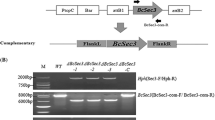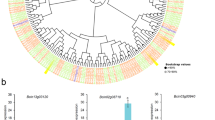Abstract
A novel conidium development mutant was obtained by screening the transformants of Botrytis cinerea produced by Agrobacterium tumefaciens mediated method, which lost the ability of producing conidia. The flanking sequence of T-DNA insertion site was acquired by TAIL-PCR technology, and then, the T-DNA insertion in the second exon of BC1G_02800.1 confirmed by BLAST between the flanking sequence and the known sequence in the B. cinerea gene database. The mutant gene was identified as BC1G_02799.1 located in the upstream of BC1G_02800.1 gene by RTPCR. The DNA full-length sequence of BC1G_02799.1 was 1951 bp and contained 1848 bp coding region, which encoded a 615 amino acids putative protein similar to ABC-transporter, and the function of BC1G_02799.1 gene was unknown to date. Phenotype analysis of the mutant found that the mutant strain colony was white, grew slowly, and did not produce conidium and sclerotia on PDA medium but showed a stronger pathogenicity to tomato leaves and successfully increased the enzyme activity related to pathogenicity compared to the wild type strain. The results suggested that the BC1G_02799.1 gene was involved in the conidium development, the sclerotia formation, and pathogenicity in B. cinerea. Our research will facilitate in understanding the molecular mechanism of conidium development, sclerotia formation, and pathogenic in B. cinerea.
Similar content being viewed by others
References
Broome J C, English J T, Marois J J, Latorre B A, Aviles J C (1995). Development of an infection model for Botrytis bunch rot of grapes based on wetness duration and temperature. Phytopathology, 85(1): 97–102
Choquer M, Fournier E, Kunz C, Levis C, Pradier J M, Simon A, Viaud M (2007). Botrytis cinerea virulence factors: new insights into a necrotrophic and polyphageous pathogen. FEMS Microbiol Lett, 277(1): 1–10
Del Sorbo G, Ruocco M, Schoonbeek H J, Scala F, Pane C, Vinale F, De Waard M A (2008). Cloning and functional characterization of BcatrA, a gene encoding an ABC transporter of the plant pathogenic fungus Botryotinia fuckeliana (Botrytis cinerea). Mycol Res, 112(Pt 6): 737–746
Doehlemann G, Berndt P, Hahn M (2006). Different signalling pathways involving a Galpha protein, cAMP and a MAP kinase control germination of Botrytis cinerea conidia. Mol Microbiol, 59(3): 821–835
Espino J J, Brito N, Noda J, Gonzalez C (2005). Botrytis cinerea endo-β-1,4-glucanase Cel5A is expressed during infection but is not required for pathogenesis. Physiol Mol Plant Pathol, 66(6): 213–221
Gourgues M, Brunet-Simon A, Lebrun M H, Levis C (2004). The tetraspanin BcPls1 is required for appressorium-mediated penetration of Botrytis cinerea into host plant leaves. Mol Microbiol, 51(3): 619–629
Kars I, Krooshof G H, Wagemakers L, Joosten R, Benen J A E, van Kan J A L (2005). Necrotizing activity of five Botrytis cinerea endopolygalacturonases produced in Pichia pastoris. Plant J, 43(2): 213–225
Kars I, McCalman M, Wagemakers L, van Kan J A (2005). Functional analysis of Botrytis cinerea pectin methylesterase genes by PCR-based targeted mutagenesis: Bcpme1 and Bcpme2 are dispensable for virulence of strain B05.10. Mol Plant Pathol, 6(6): 641–652
Kauffman H F, van der Heide S, de Vries K (1987). Botrytis cinerea: a study of the immunological properties during growth. Int Arch Allergy Appl Immunol, 83(4): 359–365
Klimpel A, Gronover C S, Williamson B, Stewart J A, Tudzynski B (2002). The adenylate cyclase (BAC) in Botrytis cinerea is required for full pathogenicity. Mol Plant Pathol, 3(6): 439–450
Li X L, Gao Z M, Li Y M, Cao Z G, Chen W, Wang S J (2008). Differentiation of pathogenicity of Botrytis cinerea strains from different hosts to tomato. Mycosystema, 27(3): 343–350
Liu W, Leroux P, Fillinger S (2008). The HOG1-like MAP kinase Sak1 of Botrytis cinerea is negatively regulated by the upstream histidine kinase Bos1 and is not involved in dicarboximide- and phenylpyrrole-resistance. Fungal Genet Biol, 45(7): 1062–1074
Mullins E D, Chen X, Romaine P, Raina R, Geiser D M, Kang S (2001). Agrobacterium-mediated transformation of Fusarium oxysporum: an efficient tool for insertional mutagenesis and gene transfer. Phytopathology, 91(2): 173–180
Panikashvili D, Aharoni A (2008). ABC-type transporters and cuticle assembly: Linking function to polarity in epidermis cells. Plant Signal Behav, 3(10): 806–809
Reis H, Pfiffi S, Hahn M (2005). Molecular and functional characterization of a secreted lipase from Botrytis cinerea. Mol Plant Pathol, 6(3): 257–267
Rui O, Hahn M (2007). The Slt2-type MAP kinase Bmp3 of Botrytis cinerea is required for normal saprotrophic growth, conidiation, plant surface sensing and host tissue colonization. Mol Plant Pathol, 8(2): 173–184
Schamber A, Leroch M, Diwo J, Mendgen K, Hahn M (2010). The role of mitogen-activated protein (MAP) kinase signalling components and the Ste12 transcription factor in germination and pathogenicity of Botrytis cinerea. Mol Plant Pathol, 11(1): 105–119
Segmüller N, Ellendorf U, Tudzynski B, Tudzynski P (2007). BcSAK1, a stress-activated mitogen-activated protein kinase, is involved in vegetative differentiation and pathogenicity in Botrytis cinerea. Eukaryot Cell, 6(2): 211–221
Segmüller N, Kokkelink L, Giesbert S, Odinius D, van Kan J, Tudzynski P (2008). NADPH oxidases are involved in differentiation and pathogenicity in Botrytis cinerea. Mol Plant Microbe Interact, 21(6): 808–819
Siewers V, Viaud M, Jimenez-Teja D, Collado I G, Gronover C S, Pradier J M, Tudzynski B, Tudzynski P (2005). Functional analysis of the cytochrome P450 monooxygenase gene bcbot1 of Botrytis cinerea indicates that botrydial is a strain-specific virulence factor. Mol Plant Microbe Interact, 18(6): 602–612
Stahmann K P, Pielken P, Schimz K L, Sahm H (1992). Degradation of Extracellular beta-(1,3)(1,6)-d-Glucan by Botrytis cinerea. Appl Environ Microbiol, 58(10): 3347–3354
Stefanato F L, Abou-Mansour E, Buchala A, Kretschmer M, Mosbach A, Hahn M, Bochet C G, Métraux J P, Schoonbeek H J (2009). The ABC transporter BcatrB from Botrytis cinerea exports camalexin and is a virulence factor on Arabidopsis thaliana. Plant J, 58(3): 499–510
Turrion-Gomez J L, Eslava A P, Benito E P (2010). The flavohemoglobin BCFHG1 is the main NO detoxification system and confers protection against nitrosative conditions but is not a virulence factor in the fungal necrotroph Botrytis cinerea. Fungal Genet Biol, 47(5): 484–496
Valette-Collet O, Cimerman A, Reignault P, Levis C, Boccara M (2003). Disruption of Botrytis cinerea pectin methylesterase gene Bcpme1 reduces virulence on several host plants. Mol Plant Microbe Interact, 16(4): 360–367
Viaud M, Fillinger S, Liu W, Polepalli J S, Le Pêcheur P, Kunduru A R, Leroux P, Legendre L (2006). A class III histidine kinase acts as a novel virulence factor in Botrytis cinerea. Mol Plant Microbe Interact, 19(9): 1042–1050
Williamson B, Tudzynski B, Tudzynski P, van Kan J A (2007). Botrytis cinerea: the cause of grey mould disease. Mol Plant Pathol, 8(5): 561–580
Wu J Y (2007). The species of cutinase and cell-wall degrading enzymes produced by Botrytis cinerea and their pathogenicity to tomato plants. Yangzhou University, 26–31 (in Chinese)
Author information
Authors and Affiliations
Corresponding authors
About this article
Cite this article
**a, Z., **ng, J., Wang, X. et al. Screening of conidium development mutant of Botrytis cinerea and functional analysis of the related gene. Front. Agric. China 5, 479–485 (2011). https://doi.org/10.1007/s11703-011-1114-2
Received:
Accepted:
Published:
Issue Date:
DOI: https://doi.org/10.1007/s11703-011-1114-2




